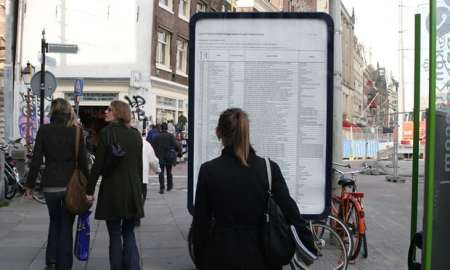
Earlier versions of The List have been posted in other locations including Amsterdam. pic from the Guardian
An artwork featuring a list of the 34,361 refugees and migrants who have lost their lives trying to reach Europe has disappeared or been destroyed in Liverpool.
The List was created for World Refugee Day. Compiled and updated each year by United for Intercultural Action – an anti-discrimination network of more than 560 organisations across Europe – The List traces information relating to the deaths of 34,361 refugees and migrants who have lost their lives within or on the borders of Europe since 1993.
Since 2007, in collaboration with art workers and institutions, Istanbul-based artist Banu Cennetoğlu has produced up-to-date and translated versions of The List using public spaces such as billboards, transport networks and newspapers.
The List was posted on hoardings outside a building site in Liverpool’s Chinatown as part of Liverpool Biennial art festival. But now it has disappeared! On Wednesday the festival tweeted this message:

The List was posted on hoardings on Great George Street with the permission of the site owners. The city council has stated that it was not removed by its workers, whether deliberately or by accident – it had been suggested that council workers might have taken it down, misidentified as illegally fly-posted. The council and the developers who own the site have been examining CCTV for clues as to who removed it on Sunday.
What is the List?Since 1993, activists at the network United for Intercultural Action have made a record of every reported instance in which someone has died trying to migrate into Europe. In all, 61 deaths were recorded in 1993; 3,915 were recorded in 2017.
What sources did they use?The small team, based in the Netherlands, drew on reports in the local, national and international press, as well as NGO records. Though the vast majority of people died during en route for Europe – most of them at sea – the List also points out that hundreds died in custody, and hundreds more took their own lives. Most deaths recorded on the List are anonymous.
How many deaths have been recorded?As of 5 May 2018, the figure stood at 34,361. But activists acknowledge that the List is neither definitive nor comprehensive. The real number is likely to be far higher, as many thousands of people will have died without trace during sea and land journeys over the years.
[from the Guardian]
United for Intercultural Action, faced with a lack of official data, gathered newspaper articles, NGO records and coastguard reports to collect details of the deaths of migrants travelling to Europe since the early 1990s. While most of the deaths happened at sea, more than 1000 happened in detention blocks, asylum units and town centres. 400 died at their own hand, over 600 violently killed by someone else. Cause of death is described quite graphically: such as “tortured by Turkish border guards near Iskenderun (TR) while trying to cross Syrian-Turkish border” and “drowned, bodies found in advanced state of decomposition 20 miles north of Zurawa LY)”.
In a statement the Liverpool Biennial said: “It is timely and important to make The List public during a global refugee crisis. We were dismayed to see it had been removed on Saturday night and would like to know why. The List has been met with critical acclaim and we are doing everything we can to reinstate it.”
To help assimilate The List across the internet, I have uploaded a pdf format copy of The list here. (The Guardian are also hosting a copy here – they’ve got a lot more available bandwidth than me, so it’d only be fair to try them first, but I’m here as a back-up if required! Happy to help!) Feel free to reproduce this link as widely as possible. Please mention ihatehate.wordpress.com and www.unitedagainstracism.org.



 Posted by Martin X
Posted by Martin X 
